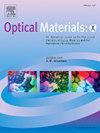研究相形成过程对具有热核结构的 Nd2Zr2O7 陶瓷的光学和热学特性变化的影响
Q2 Engineering
引用次数: 0
摘要
本文介绍了不同退火温度下相形成过程对Nd2Zr2O7陶瓷晶体结构、光学和热性能稳定过程的影响的研究结果。Nd2Zr2O7陶瓷由于Nd3离子的跃迁在光电应用中具有很大的潜力,并且对外界因素具有很高的稳定性,有可能制成透明陶瓷。研究结果表明,Nd2Zr2O7相的稳定温度为1100 ~ 1250℃,在此温度下通量最大,导热系数约为2.1 ~ 2.2 W/m × k。相变和光学性质的变化表明,退火温度的升高导致Nd2Zr2O7相的稳定,导致陶瓷结构中氧空位浓度的降低;然而,在1200°C以上的温度下,观察到的氧空位的增长是由于Nd3+阳离子取代Zr4+阳离子的影响,这导致结构中形成额外的氧空位,以及在高温退火过程中形成的立方相Zr(Nd)O2杂质夹杂物,这是相多晶化转变的产物。Nd2Zr2O7陶瓷的热物理性质的变化直接取决于相形成过程和相关的氧空位浓度的变化,这是影响传热速率的决定性因素。本文章由计算机程序翻译,如有差异,请以英文原文为准。
Study of the effect of phase formation processes on the change in optical and thermal properties of Nd2Zr2O7 ceramics with a pyrochlore structure
The paper presents the results of studies of the influence of phase formation processes with variations in annealing temperature on the processes of stabilization of the crystal structure, optical and thermal properties of Nd2Zr2O7 ceramics, which have great potential for use in optoelectronic applications due to the transitions of Nd3 ions, as well as high stability to external factors with the possibility of creating transparent ceramics. During the conducted studies it was established that the stabilization temperature of the Nd2Zr2O7 phase is 1100–1250 °C, at which the throughput is maximum, and the thermal conductivity coefficient is about 2.1–2.2 W/m × K. The assessment of phase transformations and changes in optical properties revealed that an elevation in the annealing temperature, leading to stabilization of the Nd2Zr2O7 phase, leads to a decrease in the concentration of oxygen vacancies in the structure of ceramics; however, at temperatures above 1200 °C, the observed growth in oxygen vacancies is due to the effects of substitution of Zr4+ cations by Nd3+ cations, which results in formation of additional oxygen vacancies in the structure, alongside impurity inclusions in the form of a cubic phase of Zr(Nd)O2, which is a product of phase polymorphic transformations during high-temperature annealing. Alterations in the thermophysical properties of Nd2Zr2O7 ceramics are directly dependent on phase formation processes and associated changes in the concentration of oxygen vacancies, which are the determining factor influencing the heat transfer rate.
求助全文
通过发布文献求助,成功后即可免费获取论文全文。
去求助
来源期刊

Optical Materials: X
Engineering-Electrical and Electronic Engineering
CiteScore
3.30
自引率
0.00%
发文量
73
审稿时长
91 days
 求助内容:
求助内容: 应助结果提醒方式:
应助结果提醒方式:


